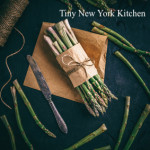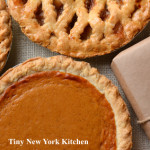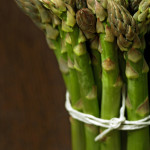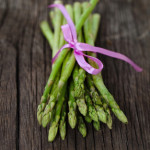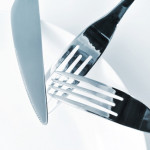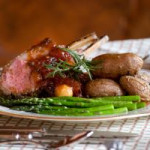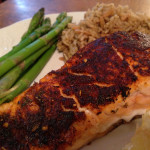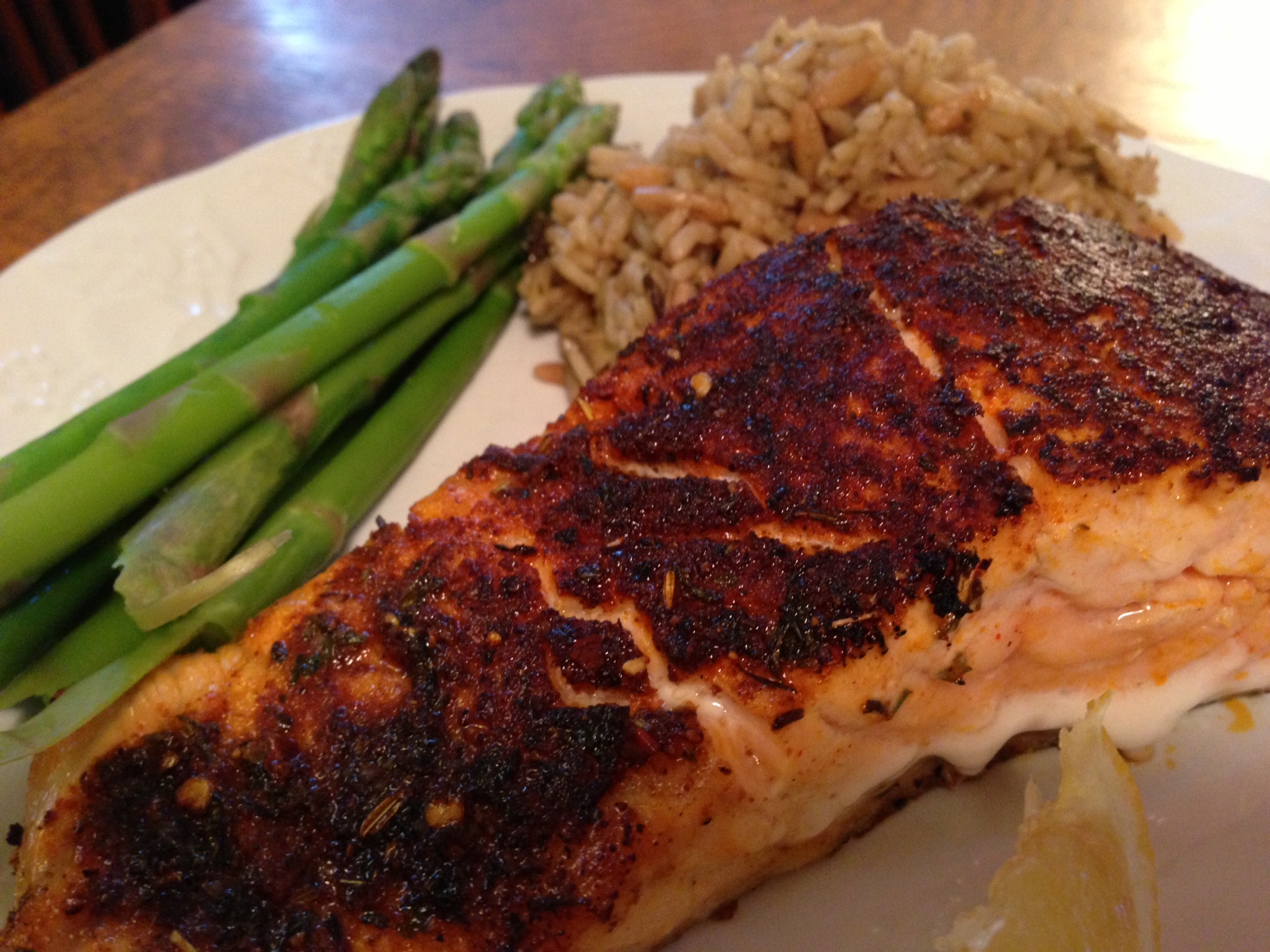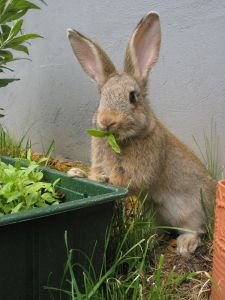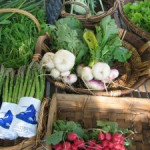If vegetables could speak, asparagus would surely say “spring.” While it’s available all year, nothing compares to the fresh spears that appear each spring. Asparagus is one of the first crops of the season, and after a long winter, when green produce is sparse, seeing the tips peek out of the soil is a welcome sight. A short shelf life means it’s best to seek out local asparagus. Look for glossy spears, tightly closed tips, and freshly cut ends.
While green is the most common asparagus, you can often find purple and white spears in stores.
Purple asparagus is grown the same way as green and is also green on the inside. These spears usually taste a bit sweeter and nuttier and are tasty raw.
White asparagus is grown without sunlight, so it doesn’t produce chlorophyll, which keeps it colorless, or white. The stalks should be peeled before cooking. It’s milder in flavor and less grassy than green and best served blanched.
“Work With What You Got!”
©Tiny New York Kitchen © 2019 All Rights Reserved
The holiday season is in full swing and soon you’ll be living on Thanksgiving leftovers. Ever had pumpkin pie for breakfast followed by a full turkey meal for lunch and another for dinner? It’s easy to get in the habit of holiday indulging.
The average American gains more than a pound each holiday season. Over a decade that really adds up. As they say, “It’s easy to put it on and hard to take off.”
There are ways to enjoy the holidays, but keep yourself in check so that you don’t fall into the trap of complete abandon.
High Fat Foods
Pigs In A Blanket: High In Fat, Salt, and Carbs.
Fried Cheese Balls: High In Fat And Small So It’s Easy To Overeat.
Baked Brie: Fatty And Addictive, Plus You Have To Slather It Onto Some Carb Calories.
Chips: They Have No Nutritional
Eat In Moderation
Cheese And Crackers: Calorically Dense And Super Easy To Eat. They’re Not Special So Spend Your Holiday Calories On Something More Festive.
Once-A-Year Favorites: You Only Eat Stuffing, Latkes, And Eggnog Once Or Twice A Year. If You’ve Been Coveting Aunt Martha’s Chiffon Pie Or Cousin Tommy’s Cooked Goose, Enjoy In Moderation.
Be My Guest
Crispy, Crunchy Crudités: Make The Brightly Colored Vegetables Your First Stop For Noshing. Add Hummus To Slow Digestion.
Pork Tenderloin, Ham Or Turkey: Protein Is Going To Suppress Your Appetite Due To The Fact That It Is Slow Digesting And Triggers The Release Of Several Satiety Hormones.
Shrimp Cocktail: Low In Fat, High In Protein And A Perfect First Course For A Low Calorie Tour Of The Buffet.
Swedish Meatballs: Another Protein Packed Option That Stands Out Amid A Carbohydrate Heavy Table.
Prosciutto Wrapped Asparagus: A Great Choice To Fuel Your Body While Keeping Your Appetite In Check.
Enjoy the holidays, but enjoy them in moderation.
“Work With What You Got!”
© Victoria Hart Glavin Tiny New York Kitchen © 2017 All Rights Reserved
Stalk Up On Asparagus
Described by the ancient physician Galen as “cleansing and healing,” asparagus is nutrient-dense, a good source of Vitamin C and high in Folic Acid. A temperate climate and rich soil ensure that asparagus tastes the best. Be sure to store asparagus upright in water to keep it fresh and firm.
Asparagus is rich in folic acid, which can help prevent mouth ulcers. It contains NO fat or cholesterol and is a perfect source of Vitamin C. Asparagus is high in asparagine, and amino acid that is helpful for removing salts from the body. This is great for people who suffer from high blood pressure or other heart-related issues. Asparagus is one of the best vegetable sources of riboflavin (Vitamin B2), which helps reduce the frequency of migraine headaches and how long they last in people who suffer from them.
“Work With What You Got!”
© Victoria Hart Glavin Tiny New York Kitchen © 2016 All Rights Reserved
Asparagus
Nothing quite says spring like asparagus, which has a rather short season, which is typically from February to June.
Thickness really has nothing to do with quality. Asparagus is a perennial; more mature plantings tend to yield thicker stalks, and any size will be tender as long as it’s freshly cut. Look for bright apple green spears and tightly closed purplish heads; the stalks should be glossy, firm, and unwrinkled, with just a little white toward the base.
The question that many people have about Asparagus is whether to peel or not to peel. I believe it is quite unnecessary, and for the effort, it just doesn’t make noticeably more asparagus flesh available for eating. Instead, bend the cut end of each spear, snapping off the woody part where it breaks naturally (usually about two-thirds of the way down the stalk). The balance of the spear will be tender to the bite.
Extend the freshness of asparagus by keeping the spears hydrated. When you get the asparagus home from the market, trim the bottom 1/2 inch or so from each stem, and stand the bunch upright in a large coffee cup. Add water just to cover the ends of the stems, and then cover the top of the bunch with a plastic bag. Or you could trim 1/2 inch off the base of the stalks, wrap the bottoms in a damp paper towel, and slip the spears into a plastic bag, leaving the bag open. In either case, make sure to refrigerate the asparagus, adding more water to the cup or dampening the paper towel as needed. The asparagus should stay fresh for up to 3 days.
“Work With What You Got!”
© Victoria Hart Glavin Tiny New York Kitchen
Perplexing Foodstuffs
There are those foods that can be rather difficult to figure out how to eat without looking like you were born in a cave. Here are some useful tips for properly eating perplexing foodstuffs.
Artichokes
Pluck off artichoke leaves and scrape the tender part (not the prickly point) between your teeth (preferably after dipping in melted butter). Work your way to the delicate inner leaves, and then use a knife to cut off the remaining small leaves and feathery innards. Cut the artichoke “heart” into bite-sized pieces and eat with a fork.
Asparagus
Eat asparagus with your fingers if served raw as crudités. Eat with a fork and knife if served with dinner.
Bread
Break bread into bite-sized pieces, and butter it or dip it into olive oil just one piece at a time.
Crab (Soft-Shelled)
Eat entire crab, including shell, either in sandwich form or using a fork and knife. Remove inedible pieces from your mouth with a fork.
Fajitas
Place meats, vegetables, and other fillings on a flat tortilla. Roll up and use your fingers to eat fajitas from one end.
Fondue
Spear bread, vegetables, or fruit with a fondue spear and dip into cheese or sauce. Remove food from spear using a dinner fork, and eat from a plate. DO NOT double dip. Spear uncooked meat cubes and place spear into fondue broth or sauce. When cooked, transfer meat to a plate using a dinner fork and cut into smaller pieces to eat.
Lobster
Wear a lobster bib to avoid fishy splatters, Crack shells with shellfish crackers and extract meat with a small fork or pick. Cut larger pieces with a knife, and eat with a fork after dipping in melted butter. Clean your hands by dipping fingers into finger bowls, and use lemon (if provided) to cut extra grease. Dry your hands with your napkin.
Peas
Use a knife to push peas onto a fork. Do not mash peas before eating, or eat peas from a knife.
Raw Shellfish
Use a small fork to extract mussels, clams, or oysters from the half-shell. Season with fresh lemon or cocktail sauce. In informal settings, you may quietly slurp shellfish from shells.
Soup
Using a soup spoon, spoon soup away from your body and then quietly sip from side of spoon. Tilt bowl away from you to spoon up remaining drops.
Spaghetti
Twirl pasta with fork tines into bite-sized portions, and allow any dangling pieces to fall back onto your fork. You may also rest fork tines against the bowl of a spoon while you twirl pasta.
Steamers
Extract clam from shell using a small fork, and use a fork and knife to remove inedible neck. In informal settings, it is permissible to use fingers.
“Work With What You Got!”
© Victoria Hart Glavin Tiny New York Kitchen
A sandwich doesn’t have to be full of fat and calories. Replace high-fat mayonnaise with one of the reduced-fat varieties. You may want to stir in some chopped fresh herbs into reduced-fat mayonnaise for a flavor boost. You may also want to hold the mayo and spread your bread with mustard, as mustard is naturally low fat. You may also want to try a spread of non-fat yogurt mixed with a bit of mustard. Chutney, delicious by itself or when blended with mayonnaise or mustard, adds a sweet and spicy dimension to a sandwich.
Many lunch meats are high in sodium and calories. Look for alternatives such as grilled vegetables or skinless chicken breast, roasted turkey breast, or shrimp in a low-fat dressing. Another good alternative is water-packed tuna.
Cheese is a high-fat sandwich ingredient that should be eaten in moderation. Choose lighter cheeses such as Swiss or low-fat cheese.
Rather than ordering your sandwich at the deli counter, take a stroll by the salad bar. There are many candidates for a great sandwich just waiting to be piled onto bread (or into a pita) and drizzled with low-fat dressing.
A few healthy choice ingredients are: artichoke hearts, roasted peppers, pepperoncini, sprouts, shredded carrots, asparagus, sliced tomatoes, and tofu.
"Work With What You Got!"
© Victoria Hart Glavin Tiny New York Kitchen
Roasted Leg of Lamb Roman Style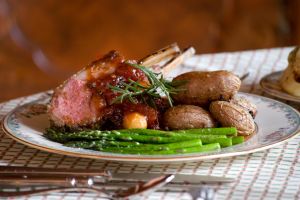
This is such an easy Sunday meal. For this traditional Roman dinner, purchase 1/4 of a nice fat “abbacchio”. In Rome “abbacchio” is a very young lamb, which has been fed only with milk. I usually purchase my “abbacchio” from a nice butcher in the Arthur Avenue area of the Bronx. If you don’t want to buy 1/4 of a young lamb then just get a decent sized leg of lamb that will accommodate the size of your family (make sure it’s not been previously frozen). Insert cloves of garlic, both lean and fatty ham, chopped stalks of rosemary, kosher salt, freshly ground pepper, and brush all over with olive oil. Salt again and roast in a medium hot oven (350 degrees) for 1 hour together with lots of raw potatoes either whole (small potatoes) or cut into pieces (larger potatoes). After about half an hour, add 1 glass of dry white wine and turn the lamb over and cook the other side for another half an hour. When the lamb is done roasting, cut into pieces and serve with the potatoes, steamed asparagus and a nice chicory salad.
Note: By the way, if you’ve never been to Arthur Avenue in the Bronx then you’re really missing quite an experience. Forget Little Italy downtown because Arthur Avenue is the real deal although tourists have discovered it as well. A great time to go is during the Christmas season. Often times they have Frank Sinatra piped Christmas songs blaring from loud speakers posted high up on the lampposts. My Arthur Avenue butcher is a total crackup. He’s in a great mood during the Christmas season because according to him it’s the one time of the year that his wife is “nice” to him if you know what I mean and he’s not shy to chirp about it either. My husband is Italian and looks it so much that they say the map of southern Italy is stamped on his face. One time I needed to pick up a few things on a Saturday during the holidays and it was so busy that there was no parking to be found. My husband found a spot, but the meter was broken. There was a “group” of Italian men donned in the “I can’t fit in my clothes” velour track suits (adorned with gold chains carrying either St. Christopher or the Virgin Mary herself) hanging around by the broken metered parking spot. My husband was inspecting the broken meter worrying about a parking ticket when the guys pipe up, “Heeeey don’t worry bout it. We’ll watch to make sure you don’t get a ticket. We’ll take care of it.” Sure enough we get back to the car after about an hour and no ticket even though we could see the NYC parking police patrolling the streets. My husband said a sincere, “thank you” to which he received a sincere “don’t mention it” and we were on our way.

“Food, one assumes, provides nourishment; but Americans eat it fully aware that small amounts of poison have been added to improve its appearance and delay its putrefaction.” – John Cage
There has been quite a bit of controversy these days about eating organic. Recent studies state that it really doesn’t matter if you eat organic foods or not. When something is labeled organic, it usually means that a farm has not used pesticides and has taken considerable care to avoid any cross-contamination. Producing organic food undoubtedly costs more money which is passed on to the consumer. Buying organic tends to be quite a bit more expensive than buying non-organic.
Honestly, I don’t care what the studies are saying about eating organic versus eating non-organic. I would rather not put pesticides into my body as well as wanting to support farmers and food companies that are not using pesticides. I love going to farmers’ markets during the spring, summer and fall and when I am shopping in the grocery store I am willing to pay a bit more for organic food.
If you have decided not to buy organic here is a list of foods that have found to be the most and least contaminated.
Most Contaminated
Apples
Bell Peppers
Celery
Cherries
Grapes
Lettuce
Nectarines
Peaches
Pears
Potatoes
Spinach
Strawberries
Least Contaminated
Asparagus
Avocados
Bananas
Broccoli
Cabbage
Corn
Kiwis
Mangos
Onions
Papayas
Peas
Pineapples

